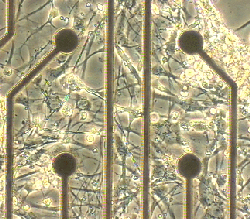Unexpected Rhythms May Reveal How Nerves Connect

Networks of nerve cells possess an unusual sense of rhythm, say researchers who grew living electrical circuits on polymer chips. The observation may require a rethink of how such networks operate in the brain, the team reports in the 18 March issue of PRL. Indeed, the experiments suggest that nerve cells connect themselves according to principles that apply to the stock market, a beating heart, and other “self-organizing” systems.
The brain contains specialized regions devoted to language, vision, and many other specific functions. Researchers believe that these subdivisions form when individual nerve cells, or neurons, link up to form distinct networks. Each network emits electrical signals at a characteristic tempo, researchers believe, so as not to get its messages crossed with others’. Current models predict that for a given network, the intervals between signals should all be roughly the same and should be distributed around the average according to a bell curve, or Gaussian distribution. No one is sure of the shape of this distribution, however, because these signals are hard to isolate in the brain.
To get around this difficulty, Eshel Ben-Jacob and colleagues at Tel-Aviv University in Israel created their own living networks of rat neurons in tiny dishes filled with a polymer that the cells require to grow. The researchers patterned the polymer and thus cultivated networks that were micrometer-wide strips of roughly 50 cells, millimeter-wide squares of 10,000 cells, and larger circles of up to 2 million cells. Using electrodes embedded in the polymer, the researchers monitored neuronal activity in the networks for days at a time.
The cells in these networks tend to fire together in bursts lasting about 100 milliseconds. The researchers tracked the length of the intervals between bursts and calculated the difference between each pair of consecutive intervals. To their surprise, they found that these differences do not conform to a bell curve. Instead, all the networks showed a similar “Lévy distribution,” which tails off more gradually at larger values. Such a distribution showed that the intervals varied more than current models allow.
Physicists know that other so-called “self-organizing” systems display similar timing patterns. Ben-Jacob and colleagues therefore interpret the results to mean that networks adjust themselves so that every one of their cells or clusters of cells fires at a single, specific frequency. This “hierarchical” organization, Ben-Jacob says, would mirror and could help elucidate the brain’s subdivision into separate systems. “What we discovered actually proves that this [hierarchy] is something which is built in,” he says.
The observation of the Lévy distribution in the timing of the networks is “unbelievably important,” says H. Eugene Stanley of Boston University, because it reflects a physical law governing their behavior. Stanley and coworkers were the first to see this distribution in the beating of the heart, which receives many neural inputs. Finding the same distribution in isolated neuronal networks establishes a key fact in how neurons work together, he says: “This is a law, they’ve discovered it, and it’s wonderful.”
–JR Minkel
JR Minkel is a freelance science writer in New York City.


